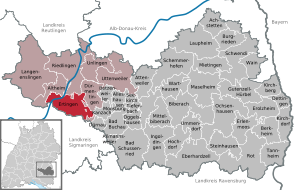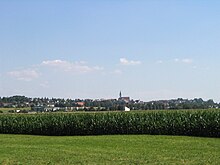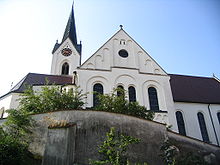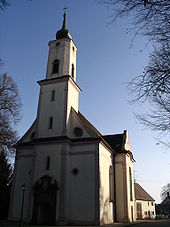Ertingen
| coat of arms | Germany map | |
|---|---|---|

|
Coordinates: 48 ° 6 ' N , 9 ° 28' E |
|
| Basic data | ||
| State : | Baden-Württemberg | |
| Administrative region : | Tübingen | |
| County : | Biberach | |
| Height : | 569 m above sea level NHN | |
| Area : | 37.74 km 2 | |
| Residents: | 5413 (Dec. 31, 2018) | |
| Population density : | 143 inhabitants per km 2 | |
| Postal code : | 88521 | |
| Area code : | 07371 | |
| License plate : | BC | |
| Community key : | 08 4 26 045 | |
| LOCODE : | DE EKB | |
| Address of the municipal administration: |
Dürmentinger Strasse 14 88521 Ertingen |
|
| Website : | ||
| Mayor : | Jürgen Koehler | |
| Location of the municipality of Ertingen in the Biberach district | ||
Ertingen is a rural municipality in the Biberach district in Baden-Württemberg .
geography
Geographical location
Ertingen is located in the western part of the Biberach district in Upper Swabia at an altitude of 550 to 580 meters.
Community structure
The community consists of the eponymous capital Ertingen and the villages of Binzwangen and Erisdorf .
history
Early and early times
Roman building remnants, which suggest a Roman manor house ( villa rustica ), were found in aerial photographs near Erisdorf in 1984/85 .
Middle Ages and early modern times in Ertingen
1265–1321 Ertingen was owned by the Counts of Grüningen-Landau . In 1273 the Knights of Ertingen were in dispute with the Salem Monastery ; The cause was a "reason to Owingen ".
In 1291 Count Eberhard von Grüningen-Landau sold farms in Ertingen to Rudolf von Habsburg . In the 14th century the place was often pawned as part of a fiefdom, so 1321-1323 to the Imperial Knights of Hornstein , 1332-1330 to Burkhard von Ellerbach , 1330-1356 to the Counts of Montford-Scheer . During this time Ertingen also changed hands, because in 1330 Count Wilhelm, Lord of Tettnang and Scheer, bought the place. In the following year, 1331, Emperor Ludwig the Bavarian granted Ertingen town rights and thus a town structure like that of the town of Lindau. From the letter to Count Wilhelm: "that he should and should make his spot [...], with moors and ditches as he wants, as his place". Ertinger Castle was mentioned in a document around 1332. It is said to have been on the Überried and was probably built on the foundation walls of Roman buildings. In any case, it was not very large, perhaps a tower and a permanent house .
From 1348 the European plague pandemic also reached Upper Swabia , the Black Death raged so violently in Ertingen that leprosy and infirmary houses had to be built outside the village. According to a legend, all Ertingers died except for an old man who married a girl from Hundersingen and all the “natives” are therefore the descendants of that couple. But it has been proven that by far not all of the Ertingers died, because around 1353 the city had around 130 households.
Between 1350 and 1370 Burg Ende was destroyed and Ertingen lost its town charter. The free farmers became serfs and Ertingen was divided among monasteries. 1387-1389 the place was destroyed by the imperial city troops in the city war. Between 1356 and 1358, Count Eberhard von Landau sold the place to Albrecht von Aichelberg , but partially reversed the sale in 1358.
The Ertingen coat of arms - mentioned for the first time in 1358 - depicts the bust of a man with two red goat horns. You can still find him today during Carnival as "Heini" and in the coat of arms of the local music association. From 1366 to 1398 Ertingen was a pledge from Stein zu Marchtal. The church was consecrated to Saint George in 1388 and mentioned as a large church in 1431.
Finally, in 1398, Ertingen came back fully into the possession of those in Landau, until it was sold to the Truchsess Eberhard von Waldburg in 1436 next to the castle, a third of the court in Binzwangen and other goods . The von Waldburg-Scheer 1437–1443 were also only brief owners .
From 1443 until secularization in Bavaria in 1803, Ertingen was one of the estates of the Cistercian monastery Heiligkreuztal . During this time the following farm owners were mentioned (1465): Diesch, Claus and Michel Beck, Holl, Höpp, Fögelin, Ströb (e) lin, App, Eberli (also Eberhard), Figel, Fryhart, Bugg and Klob. In 1484 Ertingen received a village regulation.
In 1512 Albrecht Dürer drew Siamese twins from the town, the ink drawing is today u. a. in the holdings of the Ashmolean Museum , Oxford. In 1513 the first building of the Marienkapelle could be consecrated.
In the turmoil of the Peasants' War and the Reformation of 1525–1532, the residents of the place remained Roman Catholic and in 1531 built a new church. Extreme weather also hit Ertingen; In 1560 it was so cold and hungry that on Pentecost the birds fell dead from the sky; In 1572 and 1588, however, the trees were already green in spring. In 1608 a new bell was cast for the Ertingen church.
The Thirty Years War brought looting, devastation and poverty to the population of Ertingen.
The Second World War in Ertingen
On July 12, 1944, a US high-explosive bomb fell while flying over near the Walker company. The damage was limited.
On January 18, 1944, a US Mustang P-51 fighter-bomber crashed in Schachen (residential area in Ertingen). He was hit by the anti-aircraft defense at Mengen Airport. The pilot, who died instantly, was buried in the Ertingen cemetery. The body of the lieutenant colonel was exhumed after the end of the war and transferred to the USA.
There was an attack by five fighter bombers on February 25, 1945. The attack took place on a train that was traveling between Ertingen and Herbertingen. One soldier on board was killed and eight civilian travelers injured.
The railway line near Ertingen was again the target of attacks on April 8, 1945, when a train at the Ertingen station was attacked. Bullet holes in the houses on Binzwanger and Herbertinger Strasse continued to bear witness to this attack for a long time. People weren't hurt. The only fatalities were three horses at the “Löwen” inn.
The Volkssturm was founded in Ertingen in autumn 1944 . He was trained on the weapon, had to dig holes for cover, stand guard and erect an anti- tank barrier out of tree trunks in Überried .
In the last months of the war, an air force intelligence unit was stationed in the town hall in Ertingen , which then withdrew about a week before the French army marched in.
On Sunday afternoon of April 22, 1945, when the blast of the Mengen airport shook the ground, the Wehrmacht and Volkssturm representatives closed the anti-tank barrier. This was reopened the following night by men from Ertingen at risk of death. They wanted to prevent the village from being shot at, because the units of the French army were already in Quantity 15 km away.
The first French soldiers reached Ertingen on April 23, 1945. There were no major skirmishes, the only incidents occurred at the Raiffeisenbank . There was a car of the Wehrmacht, which was manned by two soldiers who were supposed to try with their bazooka to prevent the invasion. One of the soldiers was fatally wounded in the brief engagement. The troops of the French groupement Doré drove through the place and moved on in the direction of Riedlingen with the goal of Ulm. A small detachment was stationed in Ertingen for security until the following day.
After 1945
On January 1, 1975, the municipality of Ertingen was re-formed by the union of the municipalities of Binzwangen, Erisdorf and Ertingen.
Religions
The population of the community Ertingen is predominantly Roman Catholic . The parish of St. Georg has existed since the Middle Ages. In 1531 the current church of St. George was built. A new parish hall was built in the mid-1980s. The Abbot-Bischof-Spies -Haus is in the immediate vicinity of the church.
The Protestant parish has grown strongly in recent years due to the increased immigration of ethnic German repatriates. For this reason, a Protestant parish hall was built in 2001.
In 2004:
- 4178 (2003: 4170) inhabitants and thus 74.97% of the Roman Catholic faith
- 1037 (2003: 973) inhabitants and thus 18.61% of the Protestant faith
- 358 (2003: 396) inhabitants and thus 6.42% of other faith groups or they are without confession
politics
mayor
On February 9, 2014, Jürgen Köhler was elected mayor of the municipality of Ertingen in the first ballot with 52.8% of the vote and a turnout of 57.8% (4,323 eligible voters). On April 1, 2014, he took office as the successor to Alexander Leitz.
- 1975–1998: Hans Petermann
- 1998–2014: Alexander Leitz
- since 2014: Jürgen Köhler
Municipal council
In Ertingen, the municipal council is elected using the spurious selection of a part of town. The number of local councils can change due to overhang mandates . The municipal council consists of the elected voluntary councilors and the mayor as chairman. The mayor is entitled to vote in the municipal council. The local elections on May 26, 2019 led to the following final result. The turnout was 56.6% (2014: 49.8%).
| Political party | be right | Seats | 2014 result |
| Free electoral association | 47.9% | 8th | 55.8%, 10 seats |
| CDU | 52.1% | 9 | 44.2%, 8 seats |
partnership
There is a partnership with Granges-sur-Vologne , part of the municipality of Granges-Aumontzey in France since 2016 .
economy
traffic
The community is on the Ulm – Sigmaringen railway line . However, there are currently no trains stopping in Ertingen.
In addition, the federal highway 311 Ulm - Geisingen passes between Mengen and Riedlingen Ertingen. For a long time it led through the town center until a bypass road with a 400 m long tunnel was built on the western edge of the town in the 1990s. After leaving the town to the south, the road runs parallel to the railway line in three lanes to the neighboring town.
Authorities
Ertingen has no other offices besides the town hall. The town hall on Dürmentinger Straße is responsible for the interests of the community.
Educational institutions
The Michel Buck Community School is a state school sponsored by the municipality of Ertingen. Classes 1 to 10 are taught at the school according to the curriculum of the Realschule, Werkrealschule and Gymnasium. In 2011 and 2015, the school was the state winner in the “Strong School. Germany's best schools that lead to training maturity ". The community is also a member of the VHS Donau / Bussen.
Leisure and sports facilities
Gravel was mined in the Schwarzachtal until the early 1970s . This led to the creation of a total of five large groundwater lakes, two of which, today's swimming and water sports lakes, have been completely renatured . Today the two lakes form the Schwarzachtalseen recreation and leisure center , an association of the municipalities of Herbertingen and Ertingen.
Culture and sights
Ertingen is on the western route of the Upper Swabian Baroque Road .
societies
As is customary in the Upper Swabia region, the municipality of Ertingen has a large variety of clubs, a total of 56 clubs.
Associations in Ertingen
In Ertingen, 40 clubs offer their members a wide range of leisure activities.
Sports
- The largest club in the community is the Ertingen gymnastics and sports club . In the departments of the club popular sports such as soccer, gymnastics, table tennis, skiing, volleyball, basketball, judo and fistball are carried out. Around 500 young people and 600 adults are currently active in sports in the TSV every week. The football department of TSV currently plays in the district league A in a syndicate with SV Binzwangen. Last year, after winning two relegation games in the final of the relegation, the SG narrowly missed promotion to the Danube district league. In addition, there is a game community between the two clubs in all youth groups. The table tennis department plays with its 1st men's team in the district league. The volleyball department is currently represented by a women's team in the B-Class South.
- Other sports clubs are the Ertingen tennis club, the bowling club, the Ertingen chess club, the shooting club, the “4 boys” skat group and the Ertingen windsurfers.
music
- The district of Biberach with the Biberach brass band association is the district with the highest density of musicians in terms of population. Even the smallest communities in the district have their own music association. Therefore there is of course a chapel in Ertingen. The Ertingen Music Association was founded in 1828. 80 active musicians are currently playing in the club. Another 55 young people play in the Ertingen youth band. Since the youth orchestra cooperates with the community's music associations, 10 musicians in the youth orchestra are from the suburbs of Erisdorf and Binzwangen. The 22 young musicians of the pre-orchestra also come from the 3 parts of the community. The basis for the number of musicians who actively make music in the music band under the direction of Music Director Merkle lies in the association's own training. In 2009, 82 children and young people are in training. This begins with early rhythmic education and recorder training. In 2009 the music association played between upper and maximum level. The last march music ratings and rating games were concluded "with outstanding success". The annual highlight is the annual concert in March. The music association has partnership relationships with the Unterentfelden Music Society (Switzerland) and the Naturns music band (South Tyrol).
- There is a fanfare procession in Ertingen . The Schwarzachfanfaren, founded a few years ago, are currently mainly active in the carnival. The songs practiced in intensive rehearsal work are also presented at the Ertinger Dorfhockete and at the district music festival. The Ertingen fanfare procession has disbanded, which avoids dealing with the question of whether fanfare music actually makes music or is just a form of organized riot.
- The choir "Eintracht" Ertingen has been active with its mixed choir since 1860. There is a youth choir “Happy Voices”, a children's choir “Si-Sa-Singmäuse” and a Bambini choir for very young children.
- The group “Dream & Harmony” founded in 1999 has a youth and children's choir “Little Dreams”.
Church clubs
- Catholics from Ertingen can meet like-minded people in the Kolping Ertingen family. For the Catholic youth there is the possibility to spend their free time with the Jungkolping or the KjG Ertingen.
Automotive / motorsport
- In Ertingen, BMW friends have the opportunity to join one of the 100 official BMW clubs nationwide. The BMW-Club-Ertingen e. V. is to the BMW-Club-Deutschland e. V., as a national umbrella organization. It is the only official BMW club in the Biberach district. The purpose of the association is to give everyone interested in motor vehicles the opportunity to seek advice on all technical, legal, tourist and motor vehicle issues, to exchange experiences and to organize their leisure time. Above all, cooperation with all BMW communities at home and abroad, with Bayerische Motorenwerke AG Munich, with authorized dealers, with companies in the accessories industry and with the authorities responsible for road traffic and motorization is sought.
Other clubs
- Fools guild Ertingen
Associations in Binzwangen
- Musikverein Binzwangen e. V.
- Sports club Binzwangen e. V.
- Catholic rural youth movement (KLJB) Binzwangen e. V.
- Theaterfreunde Binzwangen e. V.
- Narrenzunft Gai-Hexen Binzwangen e. V.
Associations in Erisdorf
- German Amateur Radio Club Local Association Ertingen P57
- Musikverein Erisdorf
- Women gymnastics
- Men's gymnastics
- KLJB
- "Röthenbächler" fool's association
Traditional, cultural and festive life
The annual concert of the Ertingen Music Association takes place three weeks before Easter in the festival hall in Ertingen. The musically high-quality concert is one of the highlights of cultural life in Ertingen.
On May 28, 2011 the jungle party will take place in Ertingen for the first time. The spectacle takes place in the Oberdorf gravel pit, which has been prepared as a festival area by the Ertingen music association, and the jungle atmosphere in the former gravel pit turns it into an unforgettable experience. On the eve of the Kiesgrubenhock, young and old have the opportunity to inaugurate the new festival area with a cozy squat.
The Ertingen youths celebrate the start of the new school year with visitors from the near and far area at the Smurf Party, which takes place every year on the last Friday in September. Notorious is the "Smurf Bomber", brewed according to a secret recipe and only served at the Smurf Party.
The traditional wine festival in Ertingen, which has been celebrated since 1971, is also founded in association with the “vine father” Heinrich Winter from Erzingen in Baden and takes place every year. For a number of years now, it has included an entertaining evening event on the last Saturday in October and a morning pint accompanied by brass music with lunch on the last Sunday in October.
Museums
The Michel Buck Museum is located on Dürmentinger Strasse.
Buildings
The Marienkapelle in Ertingen, a gem of the baroque era, dates from 1755. It contains a many miracle cross made of wood by Johann Joseph Christian .
Personalities
Sons and daughters of the church
- Michel Buck (1832–1888), dialect poet, doctor, researcher
- Dr. phil. Eberhard Spieß OSB (1902–1990), Abbot Bishop in Peramiho (Tanzania)
- Gerold Jäggle (* 1961), sculptor
- Gregor Peters-Rey (* 1966), composer
Other personalities
- Linus Roth (* 1977 in Ravensburg), violinist, grew up in Ertingen
literature
- Johann Daniel Georg v. Memminger: Ertingen municipality. In: Description of the Oberamt Riedlingen . Cotta, Stuttgart and Tübingen 1827 ( full text at Wikisource )
Web links
- Ertingen at LEO-BW
- Official website of the rural community of Ertingen
- Bagenga , poems by Michel Buck in Ertinger dialect in the Wikisource project
Individual evidence
- ↑ State Statistical Office Baden-Württemberg - Population by nationality and gender on December 31, 2018 (CSV file) ( help on this ).
- ^ Rolf Gensheimer: Luftbildarchäologie in Baden-Württemberg in the years 1984/85 . In: Dieter Planck (Ed.): Archaeological excavations in Baden-Württemberg 1985 . Konrad Theiss Verlag, Stuttgart 1986, p. 14ff., ISBN 3-8062-0465-9
- ^ Federal Statistical Office (ed.): Historical municipality directory for the Federal Republic of Germany. Name, border and key number changes in municipalities, counties and administrative districts from May 27, 1970 to December 31, 1982 . W. Kohlhammer, Stuttgart / Mainz 1983, ISBN 3-17-003263-1 , p. 545 .
- ↑ Preliminary results of the 2019 municipal council elections at the State Statistical Office









